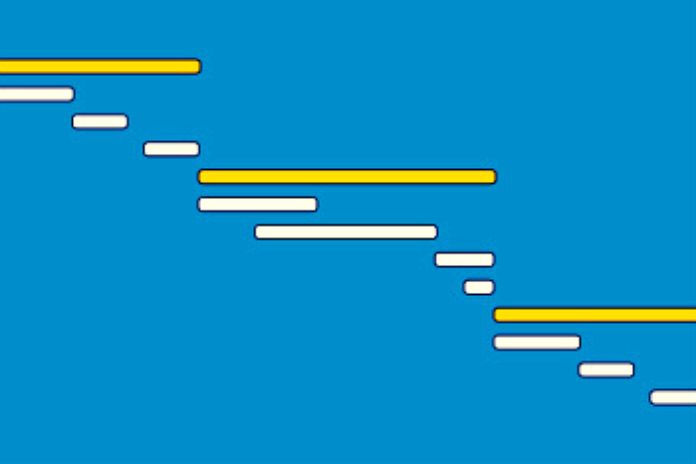Some management processes are so effective that their use has been perpetuated for decades. This is the case of the Gantt chart, created before the First World War and used all over the planet so project managers can practically follow the evolution of tasks.
Do you want to know how this happens and the impacts of using the Gantt chart in your daily life? So, read on!
What Is A Gantt Chart?
The Gantt chart is a management solution created by the American mechanical engineer Henry Gantt. This method has become popular worldwide and is already used for managing small and large projects in various areas.
How The Gantt Chart Is Structured
The Gantt chart is structured so that it is easy for any professional to follow how tasks are distributed, deadlines, and resources used. The elements are distributed as follows:
- The horizontal axis represents the execution time of each routine ;
- The horizontal bars represent the tasks, which have a size according to the time needed to execute each routine;
- Objectives and goals are distributed at the end of the graphic;
- Those responsible are usually listed on the left part of the graph, in horizontal lines, and are aligned with their taskbars;
- The critical path is the name given to all tasks that indicate the start and end of the project.
This allows for a more intuitive view of the processes and deadlines for each step. In this way, delays become less frequent, and the company can achieve better results in the medium and long term.
How Important Is The Gantt Chart In Project Management?
The Gantt chart was initially created to be used in industries. Over the years, its effectiveness has been tested in new areas, such as project management. Because it is focused on objectively visualizing information, this mechanism proved to be highly aligned with the needs of companies.
Project managers using the Gantt chart can quickly identify the progress of all activities, even on complex projects. This facilitates quick decision-making, monitoring deadlines, and other factors that may impact the project’s success.
What Are The Benefits Of Using The Gantt Chart In Project Management?
As we pointed out earlier, using the Gantt chart in the corporate environment brings several advantages. Check below how this tool helps your business to manage projects more intelligently and accurately monitor each step.
More Effective Task Segmentation
One of the strengths of the Gantt chart is its simplicity. The way tasks are distributed and transparently makes viewing each activity easy.
All activities, as well as those responsible for them, are divided into a timeline. It also presents the available resources, deadlines, and execution time of each responsibility. Thus, everyone can quickly see how a routine evolves and any existing bottlenecks.
More Transparent And Effective Distribution Of Responsibilities
A good Gantt chart helps managers to carry out a more intelligent distribution of tasks for each team. Because it is intuitive and easy to understand, the manager can quickly identify which professionals have a more significant workload and, thus, reassign responsibilities with peace of mind.
This will avoid bottlenecks and points compromising anyone’s adherence to project deadlines. In addition, the Gantt chart makes communication between leaders and employees more agile. By knowing how to visualize each routine practically, the teams will have fewer problems in the daily exchange of information in a company.
Interdependence Of Activities
In many projects, the execution of an activity is connected with completing another routine. The Gantt chart offers mechanisms so the manager can merge such practices transparently.
This makes it easy to identify which processes are connected and how delays affect the business workflow. In this way, the company can better direct its resources and ensure that everyone works in an integrated environment in search of the best possible results.
Clear Definition Of Deadlines
The Gantt chart has mechanisms to better identify the deadlines for each step. This facilitates the organization of teams and the workflow of the entire team involved in the project.
The manager can quickly simulate different scenarios, improving the planning of each step and the way processes are distributed. In this way, the project can always be structured to be executed in the shortest possible time: the manager will know how the distribution of activities affects the final deadlines and will always be ready to react in case of changes.
Increase Team Performance
The constant use of the Gantt chart to control the evolution of projects allows the business to optimize its work routines. With precise monitoring of the activities of each project, the manager will have more intelligent mechanisms to monitor failures and operational bottlenecks.
These problems can be registered in specific documentation, as well as the improvements that were made. Thus, by evaluating the results, the manager can replicate good practices and avoid risks in future projects that impact team management and performance.
The Gantt chart is today an excellent mechanism for managing deadlines for businesses looking for a more innovative way to evaluate how a project is being executed. Well-structured, it shortens deadlines, improves task direction, and gives the project manager a strategic view of each routine.
Also Read: How Big Data Can Contribute To Project Management

